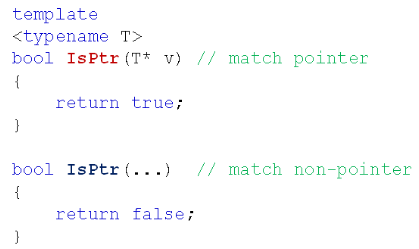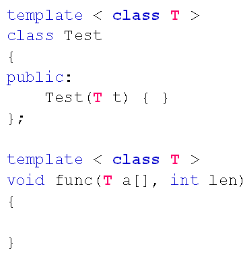0.目录
1.指针的判别
2.构造中的异常
- 2.1 如果构造函数中抛出异常会发生什么?
- 2.2 如果析构函数中抛出异常会发生什么?
3.令人迷惑的写法
4.小结
1.指针的判别
面试问题:
编写程序判断一个变量是不是指针。
指针的判别:
拾遗:
- C++中仍然支持C语言中的可变参数函数
- C++编译器的匹配调用优先级
- 重载函数
- 函数模板
- 变参函数
示例1——匹配调用优先级:
#include <iostream>
using namespace std;
void test(int i) // 1.重载函数
{
cout << "void test(int i)" << endl;
}
template
<typename T>
void test(T i) // 2.函数模板
{
cout << "void test(T i)" << endl;
}
void test(...) // 3.变参函数
{
cout << "void test(...)" << endl;
}
int main(int argc, char *argv[])
{
int i = 0;
test(i);
return 0;
}
运行结果为:
[root@bogon Desktop]# g++ test.cpp
[root@bogon Desktop]# ./a.out
void test(int i)
示例2——匹配调用优先级:
#include <iostream>
using namespace std;
template
<typename T>
void test(T i) // 2.函数模板
{
cout << "void test(T i)" << endl;
}
void test(...) // 3.变参函数
{
cout << "void test(...)" << endl;
}
int main(int argc, char *argv[])
{
int i = 0;
test(i);
return 0;
}
运行结果为:
[root@bogon Desktop]# g++ test.cpp
[root@bogon Desktop]# ./a.out
void test(T i)
思路:
- 将变量分为两类:指针 vs 非指针
- 编写函数:
- 指针变量调用时返回true
- 非指针变量调用时返回false
函数模板与变参函数的化学反应:

示例——指针判断:
#include <iostream>
using namespace std;
class Test
{
public:
Test() { }
virtual ~Test() { }
};
template
<typename T>
bool IsPtr(T* v) // match pointer
{
return true;
}
bool IsPtr(...) // match non-pointer
{
return false;
}
int main(int argc, char *argv[])
{
int i = 0;
int* p = &i;
cout << "p is a pointer: " << IsPtr(p) << endl; // true
cout << "i is a pointer: " << IsPtr(i) << endl; // false
Test t;
Test* pt = &t;
cout << "pt is a pointer: " << IsPtr(pt) << endl; // true
cout << "t is a pointer: " << IsPtr(t) << endl; // false
return 0;
}
运行结果为:
[root@bogon Desktop]# g++ test.cpp
test.cpp: In function ‘int main(int, char**)’:
test.cpp:36: warning: cannot pass objects of non-POD type ‘class Test’ through ‘...’
[root@bogon Desktop]# ./a.out
p is a pointer: 1
i is a pointer: 0
pt is a pointer: 1
非法指令
(变参函数是C语言中的东西,根本不知道对象是什么,于是会报错。)
存在的缺陷:
- 变参函数无法解析对象参数,可能造成程序崩溃!!
进一步的挑战:
- 如何让编译器精确匹配函数,但不进行实际的调用?
示例——指针判断优化:
#include <iostream>
using namespace std;
class Test
{
public:
Test() { }
virtual ~Test() { }
};
template
<typename T>
char IsPtr(T* v) // match pointer
{
return 'd';
}
int IsPtr(...) // match non-pointer
{
return 0;
}
#define ISPTR(p) (sizeof(IsPtr(p)) == sizeof(char))
int main(int argc, char *argv[])
{
int i = 0;
int* p = &i;
cout << "p is a pointer: " << ISPTR(p) << endl; // true
cout << "i is a pointer: " << ISPTR(i) << endl; // false
Test t;
Test* pt = &t;
cout << "pt is a pointer: " << ISPTR(pt) << endl; // true
cout << "t is a pointer: " << ISPTR(t) << endl; // false
return 0;
}
运行结果为:
[root@bogon Desktop]# g++ test.cpp
[root@bogon Desktop]# ./a.out
p is a pointer: 1
i is a pointer: 0
pt is a pointer: 1
t is a pointer: 0
(只匹配,不运行,就不会报错。)
2.构造中的异常
2.1 如果构造函数中抛出异常会发生什么?
面试问题:
如果构造函数中抛出异常会发生什么情况?
构造函数中抛出异常:
- 构造过程立即停止
- 当前对象无法生成
- 析构函数不会被调用
- 对象所占用的空间立即收回
工程项目中的建议:
- 不要在构造函数中抛出异常
- 当构造函数可能产生异常时,使用二阶构造模式
示例——构造中的异常:
#include <iostream>
using namespace std;
class Test
{
public:
Test()
{
cout << "Test()" << endl;
throw 0;
}
virtual ~Test()
{
cout << "~Test()" << endl;
}
};
int main(int argc, char *argv[])
{
Test* p = reinterpret_cast<Test*>(1);
try
{
p = new Test();
}
catch(...)
{
cout << "Exception..." << endl;
}
cout << "p = " << p << endl;
return 0;
}
运行结果为:
[root@bogon Desktop]# g++ test.cpp
[root@bogon Desktop]# ./a.out
Test()
Exception...
p = 0x1
p指针并没有被赋值。(对象构造抛出异常,连空指针都不会返回,也就是说不会发生内存泄漏。)
2.2 如果析构函数中抛出异常会发生什么?
析构中的异常:
- 避免在析构函数中抛出异常!!
- 析构函数的异常将导致:
- 对象所使用的资源无法完全释放。
3.令人迷惑的写法
3.1 模板中的二义性
下面的程序想要表达什么意思?

历史上的原因:
- 早期的C++直接复用class关键字来定义模板
- 但是泛型编程针对的不只是类类型
- class关键字的复用使得代码出现二义性
typename诞生的直接诱因:
- 自定义类类型内部的嵌套类型
- 不同类中的同一个标识符可能导致二义性
- 编译器无法辨识标识符究竟是什么
示例1——能编译过的普通情况:
#include <iostream>
using namespace std;
int a = 0;
class Test_1
{
public:
static const int TS = 1;
};
class Test_2
{
public:
struct TS
{
int value;
};
};
template
< class T >
void test_class()
{
T::TS * a; // 1. 通过泛指类型 T 内部的数据类型 TS 定义指针变量 a (推荐的解读方式)
// 2. 使用泛指类型 T 内部的静态成员变量 TS 与全局变量 a 进行乘法操作
}
int main(int argc, char *argv[])
{
test_class<Test_1>();
// test_class<Test_2>();
return 0;
}
示例2——模板中的二义性:
#include <iostream>
using namespace std;
int a = 0;
class Test_1
{
public:
static const int TS = 1;
};
class Test_2
{
public:
struct TS
{
int value;
};
};
template
< class T >
void test_class()
{
T::TS * a; // 1. 通过泛指类型 T 内部的数据类型 TS 定义指针变量 a (推荐的解读方式)
// 2. 使用泛指类型 T 内部的静态成员变量 TS 与全局变量 a 进行乘法操作
}
int main(int argc, char *argv[])
{
// test_class<Test_1>();
test_class<Test_2>();
return 0;
}
运行结果为:
[root@bogon Desktop]# g++ test.cpp
test.cpp: In function ‘void test_class() [with T = Test_2]’:
test.cpp:33: instantiated from here
test.cpp:26: error: dependent-name ‘T::TS’ is parsed as a non-type, but instantiation yields a type
test.cpp:26: note: say ‘typename T::TS’ if a type is meant
示例3——使用typename解决模板中的二义性:
#include <iostream>
using namespace std;
int a = 0;
class Test_1
{
public:
static const int TS = 1;
};
class Test_2
{
public:
struct TS
{
int value;
};
};
template
< class T >
void test_class()
{
typename T::TS * a; // 1. 通过泛指类型 T 内部的数据类型 TS 定义指针变量 a (推荐的解读方式)
// 2. 使用泛指类型 T 内部的静态成员变量 TS 与全局变量 a 进行乘法操作
}
int main(int argc, char *argv[])
{
// test_class<Test_1>();
test_class<Test_2>();
return 0;
}
typename的作用:
- 在模板定义中声明泛指类型
- 明确告诉编译器其后的标识符为类型
3.2 函数异常声明
下面的程序想要表达什么意思?

- try ... catch用于分隔正常功能代码与异常处理代码
- try ... catch可以直接将函数实现分隔为2部分
- 函数声明和定义时可以直接指定可能抛出的异常类型
- 异常声明成为函数的一部分可以提高代码可读性
函数异常声明的注意事项:
- 函数异常声明是一种与编译器之间的契约
- 函数声明异常后就只能抛出声明的异常
- 抛出其它异常将导致程序运行终止
- 可以直接通过异常声明定义无异常函数
示例——新的异常写法:
#include <iostream>
using namespace std;
int func(int i, int j) throw(int, char)
{
if( (0 < j) && (j < 10) )
{
return (i + j);
}
else
{
throw '0';
}
}
void test(int i) try
{
cout << "func(i, i) = " << func(i, i) << endl;
}
catch(int i)
{
cout << "Exception: " << i << endl;
}
catch(...)
{
cout << "Exception..." << endl;
}
int main(int argc, char *argv[])
{
test(5);
test(10);
return 0;
}
运行结果为:
[root@bogon Desktop]# g++ test.cpp
[root@bogon Desktop]# ./a.out
func(i, i) = 10
Exception...
4.小结
- C++中依然支持变参函数
- 变参函数无法很好的处理对象参数
- 利用函数模板和变参函数能够判断指针变量
- 构造函数和析构函数中不要抛出异常
- class可以用来在模板中定义泛指类型(不推荐)
- typename是可以消除模板中的二义性
- try...catch 可以将函数体分成2部分
- 异常声明能够提供程序的可读性